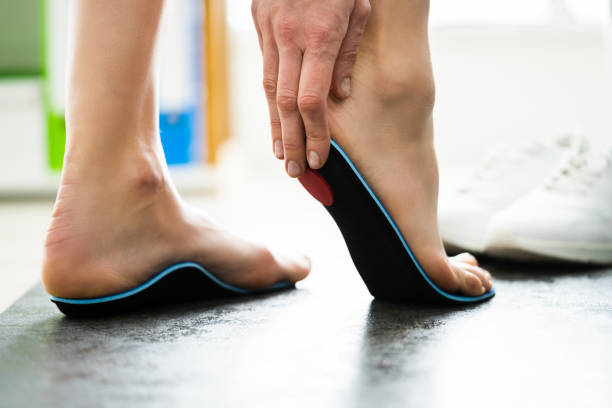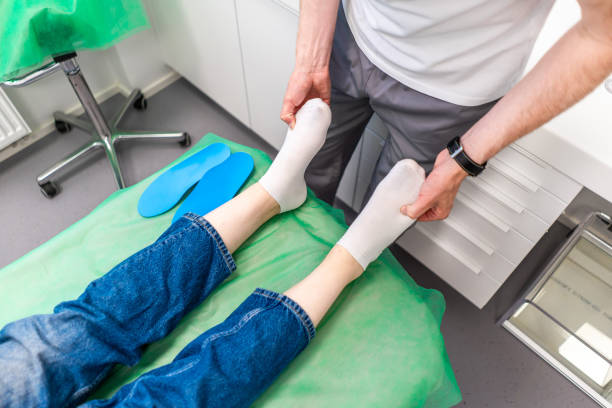Whether it’s a torn tendon or sore knee, nothing shuts down an athlete faster than an injury. Fortunately, orthotics can minimize the risk of sports injuries by providing stability and motion control.
Orthotics are designed to correct faulty foot mechanics, like pronation. They also absorb shock and reduce pressure on muscles, tendons and joints.

Preventing Injuries
The structure and function of feet has a substantial impact on the entire body’s alignment. Injuries in the lower extremity are a significant cause of premature skeletal wear and aging. Foot orthotics can correct a variety of biomechanical abnormalities, including arch height, overpronation and over-supination. These devices provide support and cushioning to the feet, helping to reduce injury by restoring normal foot mechanics.
The use of orthotics can help prevent a number of injuries in athletes that are caused by repetitive stress on the foot and ankle such as Achilles tendonitis, plantar fasciitis and knee pain. They also can increase stability and motion control in the feet and ankles and decrease overuse injuries such as blisters, shin splints and joint stiffness.
Whether you’re a casual runner or an elite athlete, you can benefit from the use of custom or prefabricated orthotics. Orthotics Pascoe Vale can help you to find a type of orthotic you need will depend on your sport, the altered foot mechanics you may have and your history with previous injuries.
Basketball, soccer and tennis players can use orthotics to add stability during rapid cuts and direction changes on the court. They can help to reduce the risk of overuse injuries such as sprains and take pressure off the ankles, knees and hips, increasing performance and endurance. Running and jogging athletes can benefit from the use of orthotics that are specifically designed to absorb shock, reduce impact loading and enhance the foot push-off phase.
Relieving Pain
Whether you are a professional athlete or a weekend warrior, the right orthotics can help prevent sports injuries. These inserts slip inside your shoes to support your feet and improve biomechanical function, alleviating pain in your foot, ankle or lower back area. These devices can be soft, semi-rigid or rigid and may be prefabricated, over the counter or custom fit.
In addition to preventing foot and lower leg pain, orthotics can also help reduce injuries by correcting abnormalities in your foot’s structure and function. Abnormalities such as high or flat arches, pronation or supination can lead to excessive stress on muscles, tendons and ligaments. These abnormalities can contribute to overuse injuries in your feet and lower legs. Wearing orthotics that support your arches and correct your abnormal foot mechanics can minimize your risk of developing overuse injuries.
When you are nimble enough to cut around a defender or shift directions on a dime, your feet and legs have to transfer a lot of force quickly. When your feet are in alignment and supporting you correctly, they can act as an effective springboard to help you reach your athletic potential.

Enhancing Performance
When you’re in pain, it’s hard to keep pushing yourself through workouts or sports. Orthotics can make it easier to stay active and train longer. They support the feet, help balance the legs and lower body and absorb shocks. That means you can take your game to the next level.
Foot problems, like flat feet or high arches, can affect your balance and lead to injury. Custom orthotics correct these biomechanical issues, minimizing the risk of injury. In addition, orthotics can enhance performance by providing added cushioning and stability to your shoes.
The relationship between overpronation and over-supination and overuse injuries is associational rather than causal, so it’s important to talk to a podiatrist before using orthotics for athletic performance. Additionally, every person’s foot is different in subtle ways. Therefore, orthotics can be effective for one person and completely ineffective for another.
Soft orthotics provide arch support, increase balance and relieve pressure from uncomfortable or sore areas of the foot. They’re made from a mold of your foot or from an image taken by a podiatrist. Semi-rigid orthotics are more rigid, preventing excessive pronation and reducing the risk of heel strike. These are typically made from a mixture of soft and rigid materials. They can also reduce stress on the knee by absorbing shock. They’re ideal for people with arthritic or diabetic feet, or who have a foot deformity.
Preventing Overuse Injuries
The use of orthotics in your shoes can help reduce the impact of high-impact sports activities on your feet and ankles. They also provide cushioning, shock absorption, and stability. These features can significantly lower your risk of overuse injuries such as shin splints, arch strain, plantar fasciitis, and stress fractures.
Orthotics are specially designed for the demands of specific exercises. For instance, runners need orthotics that control the foot’s pronation and allow for a smooth transition from heel contact to the forefoot push-off phase. Soft orthotics are typically used for this purpose. Jumpers and runners also benefit from the use of orthotics that decrease shear forces on the feet, reduce excessive pronation, and provide a stable base for the knees, hips, and back.
While some studies have questioned the efficacy of these devices, others show clear and consistent trends in favor of their effectiveness. One study showed that custom orthotics were able to decrease symptoms and the recurrence of overuse injuries in 146 runners.
Nothing can shut down your game faster than an overuse injury. With a little preventative care, you can play harder and longer without fear of injury. If you are interested in learning more about how orthotics can improve your athletic performance, contact our office today.




